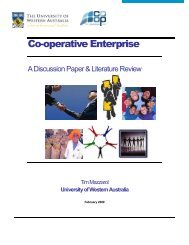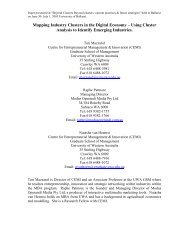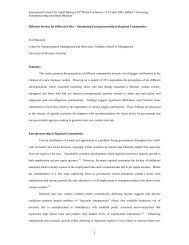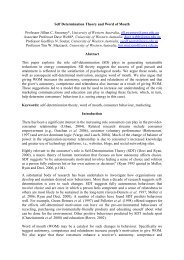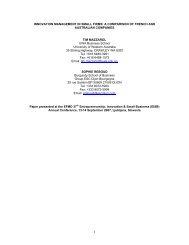The Third Wave: Future Trends in International Education - CEMI
The Third Wave: Future Trends in International Education - CEMI
The Third Wave: Future Trends in International Education - CEMI
You also want an ePaper? Increase the reach of your titles
YUMPU automatically turns print PDFs into web optimized ePapers that Google loves.
Centre for Entrepreneurial Management and Innovation<br />
<strong>The</strong> <strong>Third</strong> <strong>Wave</strong>: <strong>Future</strong> <strong>Trends</strong> <strong>in</strong> <strong>International</strong> <strong>Education</strong><br />
9<br />
overseas <strong>in</strong>stitutions. For example, the Indian School of Bus<strong>in</strong>ess, Hyderabad has commenced negotiations<br />
with the University of Pennsylvania’s Wharton School of Bus<strong>in</strong>ess, and North Western University's, Kellogg<br />
School of Bus<strong>in</strong>ess.<br />
IDENTIFYING THE DIRECTION OF THE “THIRD WAVE”<br />
<strong>The</strong> matur<strong>in</strong>g of the global education market can be seen <strong>in</strong> the slow<strong>in</strong>g of the annual average growth rate for<br />
higher education students dur<strong>in</strong>g the last two decades (Kemp 1990; Mazzarol and Hosie 1996). Although ‘First<br />
<strong>Wave</strong>’ recruitment cont<strong>in</strong>ues and ‘Second <strong>Wave</strong>’ licens<strong>in</strong>g and contract<strong>in</strong>g rema<strong>in</strong> important, there is a<br />
question over the future direction of <strong>in</strong>ternational education. As already noted, the establishment of<br />
<strong>in</strong>ternational branch campuses raises a question as to whether this represents a ‘<strong>Third</strong> <strong>Wave</strong>’ <strong>in</strong> education<br />
<strong>in</strong>ternationalisation (World Trade Organisation 1998). Possible strategic options for <strong>in</strong>ternational education<br />
service providers <strong>in</strong>clude: 1) Open<strong>in</strong>g branch campuses (usually <strong>in</strong> conjunction with jo<strong>in</strong>t venture partners), 2)<br />
partner<strong>in</strong>g with private sector groups to provide ‘corporate university’ delivery models, and 3) Us<strong>in</strong>g ICT-based<br />
delivery to create ‘virtual universities’. Each of these options, or some comb<strong>in</strong>ation of the three, provides a<br />
potential ‘<strong>Third</strong> <strong>Wave</strong>’ <strong>in</strong>ternationalisation model.<br />
<strong>The</strong> development of a branch campus is similar to the construction of a manufactur<strong>in</strong>g plant <strong>in</strong> an <strong>in</strong>ternational<br />
market. While it <strong>in</strong>volves the greatest level of <strong>in</strong>vestment, and, therefore, risk, it may provide greater control<br />
and a better return on <strong>in</strong>vestment. <strong>The</strong>re are many forces motivat<strong>in</strong>g the establishment of branch campuses<br />
but such an establishment often seems to be driven by the policies of the governments <strong>in</strong> the “home” country.<br />
Malaysia, for example, has long had a desire to become a net exporter of education services (Powell 1994).<br />
<strong>The</strong> lack of an adequate supply of higher education places dur<strong>in</strong>g the 1970s and 1980s drove the demand for<br />
<strong>in</strong>ternational education among Malaysian students, who are one of the largest national groups <strong>in</strong> the global<br />
market (UNESCO 1999). Faced with this ‘bra<strong>in</strong> dra<strong>in</strong>’ and a leakage of foreign exchange, the Malaysian<br />
government took action to build supply, <strong>in</strong>itially through ‘Second <strong>Wave</strong>’ tw<strong>in</strong>n<strong>in</strong>g arrangements (Ng 1995).<br />
Parallel to the growth of branch campus models, has been the development of alliances between large<br />
corporations and universities or university consortia. <strong>The</strong>se alliances provide such corporations with advanced<br />
tra<strong>in</strong><strong>in</strong>g and education services, traditionally provided by <strong>in</strong>ternal tra<strong>in</strong><strong>in</strong>g and development departments. <strong>The</strong><br />
‘corporate university’ appears to date from the 1980s, with the number of such <strong>in</strong>stitutions <strong>in</strong> America grow<strong>in</strong>g<br />
<strong>The</strong> growth has been motived by a recognition by many large companies that ‘tra<strong>in</strong><strong>in</strong>g’ needed to be replaced<br />
by a more susta<strong>in</strong>ed <strong>in</strong>vestment <strong>in</strong> their <strong>in</strong>tellectual and human capital. In 1999, Australia’s Coles-Myer Limited<br />
formed an alliance with Deak<strong>in</strong> University to create a corporate university called the Coles Institute. This jo<strong>in</strong>t<br />
venture will offer Coles-Myer’s 50,000 employees an opportunity to pursue higher education (Deak<strong>in</strong><br />
University 1999).<br />
Some alliances <strong>in</strong>volve ‘bricks and mortar’ <strong>in</strong>stitutions, while others are virtual <strong>in</strong> nature. Large <strong>in</strong>ternational<br />
firms, such as Toyota, Motorola, Dell Corporation, Sun Microsystems and Verifone, have established virtual<br />
<strong>in</strong>stitutions that deliver courses on-l<strong>in</strong>e. Given their global reach, these alliances offer the potential for<br />
university programs to be carried around the world <strong>in</strong>to all the markets <strong>in</strong> which corporate partners are<br />
operat<strong>in</strong>g. <strong>The</strong> delivery of specialised courses, such as tailored MBA programs, to <strong>in</strong>dividual corporate clients is<br />
not new (Nicholls 1995). However, the model is likely to become more common as education <strong>in</strong>stitutions seek<br />
to secure f<strong>in</strong>ancially beneficial contracts with corporate partners that can assist <strong>in</strong> open<strong>in</strong>g new offshore<br />
markets.<br />
<strong>The</strong> application of ICT to education is another major trend <strong>in</strong> the <strong>in</strong>ternationalisation of education services.<br />
One of the first major ‘virtual university’ models to be created was America’s Western Governor’s University.<br />
This organisation was established by the Governors of seventeen western State Universities and is allied to<br />
Centre for Entrepreneurial Management and Innovation | www.cemi.com.au



